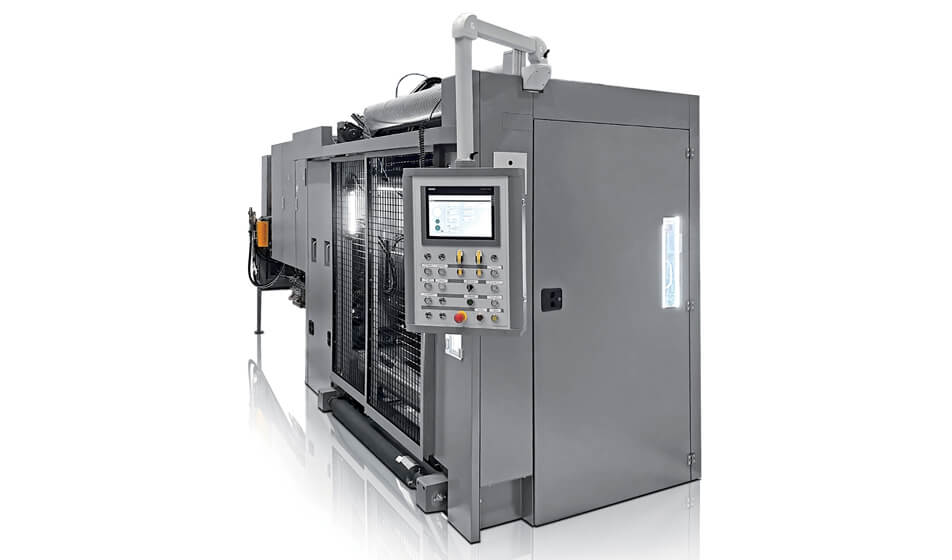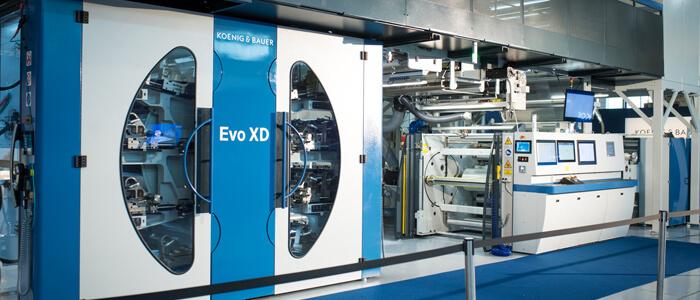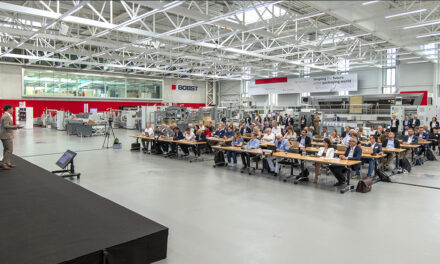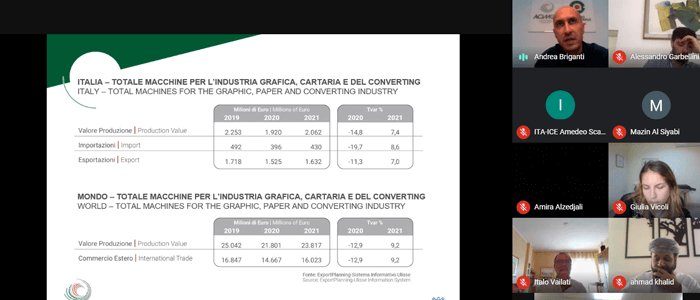To reach new levels of flexibility in packaging production and printing, Bobst rethinks coating and finishing processes and invents Multi-Stack Unit: a “bivalent” flexo-roto unit that enables the desired technology to be activated in minutes, with great economies and maximum simplicity.
The Need
When we talk about hybridization between technologies in the narrow web, we usually refer to a combination of flexo and roto, offset, digital to flexibly handle variable data, finishing and finishing. If, on the other hand, we talk about mid-range and wide web, the subject changes and the focus also goes to coating. The market demands more and more sophisticated packaging, requiring the integration of the press with units capable of carrying out countless types of finishing, coating, functional, personalization… and also to ensure the new sustainable materials that R&D is creating at a rapid pace the necessary barriers to guarantee the shelf life of the products. But.
“But” at the same time, the converter needs simplicity and sustainable costs, while its lines tend to become more and more complex and expensive, slowed down and difficult to manage-and we know how having “user friendly” equipment today is more important than ever.
The challenge
Composing all these somewhat conflicting requirements into a single, well-functioning and sustainable machine is quite a challenge for designers. Bobst has taken it up and developed a solution as simple and essential as Columbus’ egg.
By pooling the know-how of the Competence Centers in San Giorgio Monferrato (roto, laminating and coating) and Bielefeld (mid-range and wide-web flexo), and taking the best of the group’s historical technology, the Swiss manufacturer has worked to create a “multi-stack” unit that integrates the two processes flexo and roto. To be activated in minutes as needed, in order to perform, on any type of plastic and cellulosic substrate, the different types of finishing and converting: additional printing colors, varnishing, coating, cold sealing….
The solution
It is called the Multi-Stack Unit and is designed to be able to work in an integrated line downstream of a central drum flexo-or a roto or other-with an immeasurably lower investment than buying two separate stations. Easy to manage and with switching from one technology to the other in a matter of minutes, it works on a single platform with an optimized process, including sustainability: the Multi-Stack Unit takes up limited space, the single inline pass requires less energy than the sum of specialized inline or stand-alone units, and it enjoys the efficiency of Bobst’s drying technology. Sara Alexander, marketing and communications manager for roto printing, laminating and coating lines at Bobst Italia in San Giorgio Monferrato, Italy, and Marco Carrara, Technology Sales Director of CI Flexo for printing and converting, based in Bielefeld, D, describe it to us.
Just born, everyone wants it
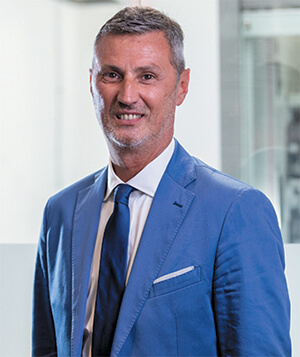
Marco Carrara
“Today to do a roto coating on a flexo machine you have to buy a special unit and integrate it into the line, and the same goes for flexo coatings for which you have to have additional units. The investments are high and the lines are getting bigger and bigger and more complicated to run. The problem had to be addressed: users were expressly asking us: first a German customer, then a large Austrian group…,” Marco Carrara begins. Who adds another thought-provoking consideration: “R&D of new sustainable substrates is racing on, with new characteristics and always new requirements for coatings and barrier coatings, and it is difficult for converters to predict what they will need as early as tomorrow. Equipping ourselves with a unit where we can do all types of coating to be able to respond to increasingly varied and changing needs is now essential to preside over the market, and the fortune of the Multi-Stack Unit is proof of that: we made the first two to respond to specific requests, but then we saw that this solution was of great interest, and we industrialized it for mass production. Even before we officially presented it to the market, we had already sold four of them, and by now the potential for commercial development is clear: the Multi-Stack Unit responds to a widespread need.”
At the origin of the idea
“Being able to combine the know-how of San Giorgio and Bielefeld, the development was relatively fast,” says Marco Carrara-“We started working on it last summer starting with a simple request for a flexo unit for coating. But then the customer started getting requests for cold seal, which he could only do by buying an ad hoc roto unit or by working off-line on a laminator…. The idea of making a unit that could handle both flexo and roto technologies came from here.”
“Our multiple unit solved the problem at the root: starting from well-proven technologies and with a reduced investment, that converter has equipped itself with a tool that allows it to perform on all materials, from polyethylene to paper, all possible types of processing. And thus to face, with extreme flexibility, the developments of a demand in the midst of experimentation, which takes a thousand rivulets and still has few certainties,” Alexander points out.
An astute play of cylinders, and more

Sara Alexander
The very heart and meaning of Bobst’s Multi-Stack Unit lies in the rapid changeover of technology “because, of course, if moving from flexo to roto required stopping the machine for hours, the advantage would be greatly reduced.” On the Multi-Stack Unit this changeover is done in as little as 6 minutes, aided by lightning-fast makeready, a very advanced self-cleaning inking system, automatic registration and an advanced drying system, all of which keep job quality high throughout the entire run. But the secret-the famous egg of Columbus-lies in the interplay of rollers that are managed so that they can work, alternately, as flexo or roto elements.
“In our Multi-Stack unit,” says Carrara, “the printing cylinder and the roto impression roller can change places and take over the function of the plate cylinder and flexo anilox, and even if the doctor blade chamber has to be replaced, overall the transition is simple and very quick. The result is flexibility that has never been achieved with the minimum of interruptions and with the guarantee of automatic and uncomplicated command and control of parameters, managed by the supervisor of the unit itself.”
The Multi-Stack Unit easily achieves operating speeds of 600 m/min in line with Bobst flexo presses, rising to 800 m/min depending on the job, and is available in widths of 1250, 1560 and 2150 mm in flexo and 1250 mm in roto. Up to 4 multi-stack units can be installed to complement a machine, without compromising system performance.
The market demands multifunctional solutions
“At first we thought we would develop and offer it only for the higher-end configurations of gravure and center-drum flexo presses, but then we came to our senses: the Multi-Stack Unit brings value regardless. In fact, by adapting, for example, the design to the different flexo CI models, we recently sold 4 of them, two for the MASTER CI model and two for the VISION CI model, thus confirming its validity for converters of all sizes.” Sara Alexander and Marco Carrara agree. It is not only a matter of taking advantage of all the business opportunities opened up by an innovative and novel solution- Bobst is the first to propose this type of technology – but also of looking beyond the contingent opportunity, to see how the market develops. A market, the two managers consider, largely made up of food packaging, an immense world that ranges from snacks to fresh through pet food, and that has been asking for machines that do more than just print for a few years now. “In order to serve the increasingly sophisticated demands of brand owners,” Alexander explains, “but also because of the whirlwind development of more sustainable alternative materials for all flexible packaging applications. Coating requirements change accordingly, making it difficult to predict which coating technology to opt for. Better gear up to be able to do it all!”
What about sustainability? Environmental, economic and cultural
Bobst’s Multi-Stack Unit was born out of an operational and economic need, but the sustainability benefits are not insignificant. “Taking up little space, wasting less material in the startup phase because we work on just one unit, consuming less energy, saving time … all make the Multi-Stack Unit sustainable by nature, with the corollary of derived economic savings that are anything but marginal,” Carrara points out. And then-repeats Alexander-it makes it possible to work with the new sustainable materials that everyone is striving to develop, and it triggers a culture of collaboration that is vital today: “The fact that Bobst can field all the technologies is an incredible advantage, especially since distant worlds are coming together today, such as metallization and printing, for example. Customers are asking for solutions, they are asking questions, and to be prepared we have to be able to listen to them and integrate as much as possible the competencies, of supply chain partners and our own internal ones. Overcoming even geographic and “supporter” barriers: and it is great to see teams from the various technology centers regard colleagues with interest and pride, aware of the excellence of each other’s skills and the enormous potential of collaboration”.

